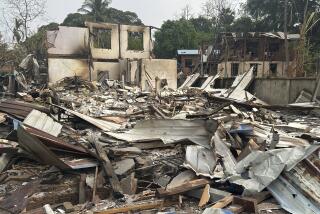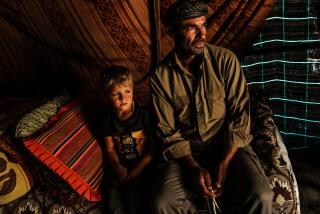Bringing Aid and Security to E. Timor a Delicate Balance
- Share via
CAI RUI, East Timor — The sun is just rising over the brown hills as the Gurkha captain briefs the drivers of the 18-vehicle humanitarian convoy: Stay close, don’t go more than 36 miles an hour, keep within 120 feet of the next vehicle and, if a pro-Indonesian militia attacks, back up your vehicle to a safe place and lie down on the car floor until the Gurkhas can rescue you.
Nearly a month after the first U.N.-sanctioned peacekeeping forces landed in Dili, the capital of East Timor, security and humanitarian issues in the territory are growing increasingly complex, political and intertwined.
Over several hours of driving, the lungs of the convoy’s doctors, nurses, aid workers and soldiers are tested as dust pours off the hot, empty road. Fortunately, the group’s nerves under gunfire are not put to the test. Even if they were, however, it would be only a small taste of what the East Timorese have endured for weeks.
As the U.N. vehicles finally lurch to a halt in the small village of Cai Rui, about 50 miles west of Dili, a cheer breaks out. The convoy is loaded with 16 tons of rice, cooking oil, crackers, various medicines and tarpaulins--and these villagers, many barefoot, have been living on cassava and roots for several weeks.
Up to 10,000 refugees now live in this area, in large part because it is a stronghold of the Falintil, the anti-Indonesian guerrillas. The large refugee influx has, in turn, left many people hungry, crowded and in need of medical care.
“More than 20 people now stay in our house with us,” says Anna da Costa, cradling her sick 1-year-old daughter, Rita. “Before, just the six of us lived here.”
The events that upended so many people’s lives started four days after the residents of East Timor voted Aug. 30 to separate from Indonesia. As threatened, local militias working with the Indonesian army went on a rampage across the troubled territory.
The militias’ handiwork--entire cities and towns burned beyond recognition--is a testament to the price of failed diplomacy. In desperation, hundreds of thousands of East Timorese were forced to flee their burning homes and head for the hills, out into more remote areas or into the adjoining Indonesian province of West Timor.
The region around Cai Rui, with its promise of Falintil protection, proved a magnet for many people from Manatuto, a large village midway between East Timor’s two principal cities, Dili and Baukau.
In addition to the crowds lining both sides of Cai Rui’s single dirt road to greet the convoy are 30 armed Falintil guerrillas, several carrying assault rifles. This is arguably the largest face-off between weapons-carrying Falintil members and peacekeepers since the Australian-led forces arrived.
The rebels’ arms create another dilemma in the strange no man’s land that is East Timor. Technically, the territory is still part of Indonesia, at least for another several weeks, until the national parliament votes whether to let it go. And the mandate of the peacekeeping forces is to disarm anyone who is not in the Indonesian military--pro-Indonesian militia forces and Falintil members alike--and hand these people over to the Indonesian police.
In practice, however, there are now only a few dozen Indonesian police left in East Timor, and they are fast heading for the border. And if Falintil members were handed over to them, the captives’ lives could be in danger. Indonesian police have worked closely with the military to crush the guerrillas over the past 24 years--ever since Indonesia invaded the former Portuguese colony in 1975--so there’s no love lost. Nor are the local Indonesian authorities exactly neutral: Reports suggest that many pro-Indonesian militia members who were handed over to Indonesian police were quickly released, freed to make more trouble.
Faced with the heavily armed Falintil platoon in Cai Rui, the convoy’s Gurkha-dominated troops ask the guerrillas to disarm. The Falintil force refuses.
“It became very tense indeed,” says Maj. Gen. Peter Cosgrove, commander of the peacekeeping forces, back in the capital several hours later. “There could have been bloodshed right at that time.”
Beyond ego and pride, there’s a more down-to-earth problem here: The peacekeeping forces will leave Cai Rui in three hours and return to the relative safety of Dili, well before darkness descends. If the Falintil troops are disarmed, thousands of defenseless people will be vulnerable to a fresh wave of violence.
After further consideration, the rebels in Cai Rui are allowed to keep their weapons.
“Our disarmament policy hasn’t stopped,” says British Flight Lt. Mark Larter, an officer in the convoy standing beside a Land Rover. “But what can we do? I don’t think we can leave these people here unprotected.”
Before too long, the Falintil and the Gurkha and Australian peacekeeping troops are busy comparing weapons and making small talk.
Cai Rui villagers, meanwhile, are quick to express their appreciation for the food and medical attention. Within minutes, the aid group Doctors of the World and the Gurkhas have set up separate facilities at opposite ends of the village.
Long lines quickly form in front of these makeshift clinics under the eves of one-room thatched huts--the groups’ antiseptic needles and shiny scalpels offering a sharp contrast to the dirt-packed floors and the clusters of muddy children and barefoot mothers run down by fever, malaria and dysentery.
But local residents are also quick to voice what’s really on their minds: their frustration at how long it’s taking before they can return home.
“We need U.N. troops not only in the cities but in the small towns, so people can feel secure and start their lives again,” says Nunu Monij da Silva, a farmer who says he walked for more than a week with his small children to reach Cai Rui from Manatuto. “It may look all right here, but it’s not the way it seems. Even a single militia can cause problems.”
Two weeks earlier, far more than that happened, according to villagers and local Falintil guerrillas. After burning a neighboring village, a group of 35 armed militiamen and Indonesian soldiers set their sights on Cai Rui. A gun battle followed between the invaders and the Falintil.
“The Falintil made them leave,” says platoon leader Foho Rai Bot, who sports a scraggly beard, fatigues and two mismatched pistols. “We killed one militia, but five Falintil were wounded.”
Aid workers, meanwhile, echo the security complaints and say they need more widespread protection to do their job--before the rainy season kicks in later this month and makes travel nearly impossible.
“They pass through and don’t leave anyone here--why do they have a convoy to one place and then go back to Dili?” says Laura Weisgerber, a spokeswoman for Doctors of the World. “These villagers are terrified. Leave someone here for 24 hours, even as a symbolic gesture.”
Military officials respond that security after such a breakdown in social order takes time and that people must be patient. Furthermore, they insist, the Falintil must disarm, along with everyone else in the territory, so civil order can be restored.
“For this territory to be at peace, we must take the arms out of the hands of those who are untrained and unsanctioned as a military force,” Cosgrove says.
Falintil leader Jose Alexandre “Xanana” Gusmao, meanwhile, has said in Darwin, Australia, that he opposes disarming the Falintil at least until East Timor is free of militia violence.
This tension between common sense and official policy is partly a function of international politics, Western diplomats say. Not only is Indonesia still nominally in charge in East Timor, but the Indonesian government’s goodwill is also still needed to help refugees who fled--or were pushed--into West Timor.
Aid workers say West Timor is shaping up as a far greater long-term humanitarian crisis than East Timor. An estimated 140,000 to 240,000 East Timorese are in West Timor, a sizable portion of the estimated 850,000 residents of East Timor before the violence erupted.
Officially, Indonesia says the refugees in West Timor are free to go wherever and whenever they like. In reality, Western aid workers say they have difficulty getting into the refugee camps in the province, which militias often control, amid fears that the refugees could face forced relocation to other parts of Indonesia.
Earlier this month, there was a small bit of good news, however, when Indonesia said it would allow about 100 refugees to return from West Timor. And by Friday, about 1,800 displaced people had been flown back.
* PEACEKEEPERS KILL 3 MILITIAMEN
Three anti-independence militants are killed and three others hurt in a clash with peacekeepers in East Timor. A11
More to Read
Sign up for Essential California
The most important California stories and recommendations in your inbox every morning.
You may occasionally receive promotional content from the Los Angeles Times.













